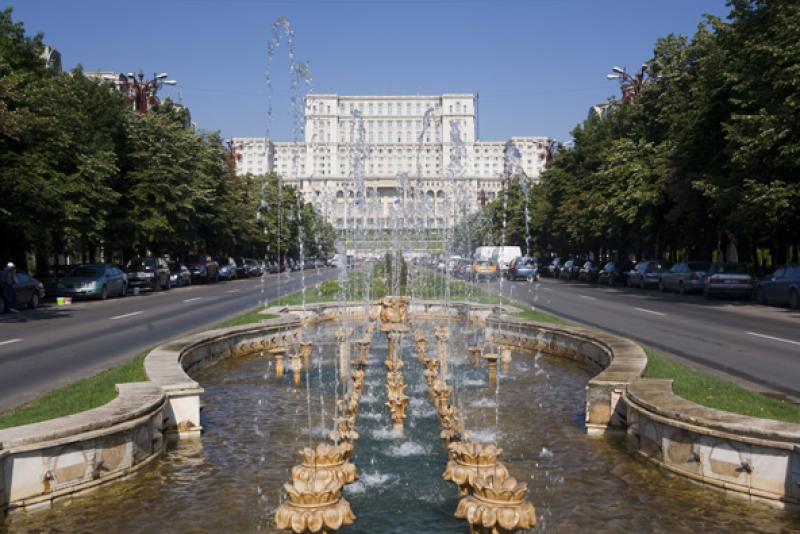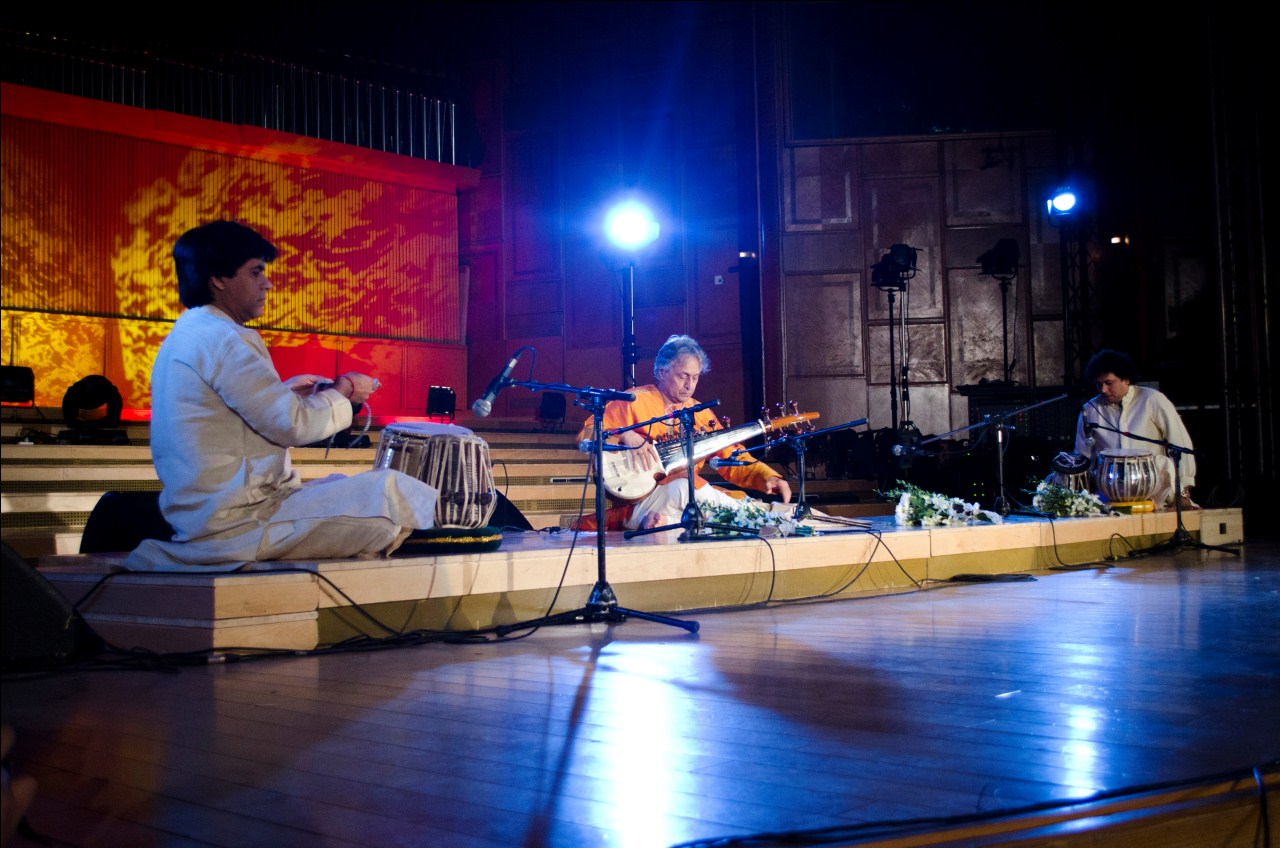theartsdesk in Bucharest: The Paris of the East? | reviews, news & interviews
theartsdesk in Bucharest: The Paris of the East?
theartsdesk in Bucharest: The Paris of the East?
There may be holes in the pavements and little street lighting, but the Romanian capital is competing with the big arts festivals

The tourist bumf talks a lot about Bucharest being “Little Paris”. If you squint while walking down the grand boulevards, you see what they mean. The crumbling Byzantine churches, the Belle Époque restaurants, the odd palatial Beaux-Arts town houses among the brutalist blocks all evoke Paris. They even have their own Arc de Triomphe and Odéon Theatre here, built on Parisian models.
What Paris can’t boast, though, is the absurdly pompous Casa Popurului (the House of the People) dreamt up by Ceausescu. The guides will tell you it’s the second biggest administrative building in the world after the Pentagon. There are five-ton crystal chandeliers, with a million cubic metres of Transylvanian marble. One of the reception halls was supposed to have an open roof so that Ceausescu could land his helicopter inside. It’s wonderfully hideous totalitarian Las Vegas chic.
I was told Bucharest has the biggest Ferrari dealership in Europe, which you can well believe
The two least Parisian museums must be the Muzeul Taranului Roman (or Peasant Museum), and the Muzeul Naţional al Satului Dimitrie Gusti (the Village Museum). The Peasant Museum, with its red-brick facade, has a rich collection of ceramics, peasant furniture and other rural artefacts, which are more fascinating than that might sound. At the beginning of the 1950s, the collections were moved away from the museum and replaced by the exhibits of “the history of the Communist Party and the Revolutionary and Democratic Movement in Romania”. After the collapse of the Communist regime, the collections returned to their rightful place. The Village Museum (pictured below right), which was founded in 1936 by royal decree, is an open-air architectural museum of farm houses, windmills and other country buildings that were moved to the capital.
 The city outscores Paris in some ways. I was told that Bucharest has the biggest Ferrari dealership in Europe, which you can well believe. The local paper ran a story about the thousands of Porsches in the city, and car enthusiasts can have hours of fun spotting Maseratis, Lamborghinis, Cadillacs and other luxury cars. I walked down one road, trying to avoid falling in holes, and at a scruffy-looking shop saw jackets for sale at a thousand euros.
The city outscores Paris in some ways. I was told that Bucharest has the biggest Ferrari dealership in Europe, which you can well believe. The local paper ran a story about the thousands of Porsches in the city, and car enthusiasts can have hours of fun spotting Maseratis, Lamborghinis, Cadillacs and other luxury cars. I walked down one road, trying to avoid falling in holes, and at a scruffy-looking shop saw jackets for sale at a thousand euros.
“We have an image problem,” says Mihai Constantinescu, director of the prestigious Enescu Festival which runs every two years. The old image problem was the famous packs of feral wild dogs in the streets and gangs of gypsy beggar children, who made navigating the streets on foot tricky. There are hardly any of the rabid dogs, and I was told the top beggars have left town. “All of the pick-pockets have moved to Western Europe where the pickings are so much better.”
There is still a lot of antagonism towards the gypsies: probably Romania's top music export in the past decade has been the gypsy group Tafaf De Haidouks (Band of Outlaws) but no one connected to the music scene here that I spoke to had a good word to say about them, or any gypsy music, claiming it wasn't really Romanian anyway.
Watch video of Michael Palin at the "House of the People"
The new image problem is the poor infrastructure, the corruption and what one hesitates to call the Mafiosi, but it would be fair to say that not all those driving around town in Ferraris came into possession of their wheels through totally honest means. Constantinescu is bracingly direct about this, when I ask him how the population reacts to the authorities putting about eight million euros into the Enescu Festival. “It’s only once every two years and the people can see what we have spent it on.” He contrasts that with other large-scale funding for things like, yes, street and pavement repair which often end up in assorted back pockets rather than actually making any improvements.
That the Government is willing to fund the arts is not untypical for Eastern Europe – the Poles invested four million euros for their Polska Year festival in the UK last year, for example. And after a rocky period in the 1970s and 1980s, following the Ceausescus' execution in 1989 (the country banned capital punishment the week after his death) the Enescu Festival has flourished and invites some of the top names to compete with the biggest festivals such as Salzburg.
This September they added a world music component, so when I was there you could jump from a concert by the superb Latvian violinist Gidon Kremer, doing experimental versions of Bach, or Zubin Mehta conducting the Israeli Philharmonic, to jazz-electronica from the Lebanese pianist Rami Khalifa and his band or Indian classical music.
 It seemed many of the Bucharest audience were “world music” virgins, but what they lacked in experience they made up for in enthusiasm, listening intently to sarod maestro Amjad Ali Khan playing (pictured left) with great bravura and dignity. The big hit among the locals in the world section was Yasmin Levy, who sold out the Mihail Jora Hall. She was performing her Ladino songs (the music of Jews expelled from Spain in the 15th century) as well as newer flamenco-ish songs.
It seemed many of the Bucharest audience were “world music” virgins, but what they lacked in experience they made up for in enthusiasm, listening intently to sarod maestro Amjad Ali Khan playing (pictured left) with great bravura and dignity. The big hit among the locals in the world section was Yasmin Levy, who sold out the Mihail Jora Hall. She was performing her Ladino songs (the music of Jews expelled from Spain in the 15th century) as well as newer flamenco-ish songs.
The 1,000-seater Athenaeum is the most charismatic building the concerts take place in. With its impressive dome based, as the name suggests, on a Graeco-Roman amphitheatre, and surprisingly good acoustics, it’s worth going in to look at even if there isn’t any music on. With prices for Romanian citizens kept low at an average of around £9 (the 90 per cent subsidy helps), none of them were complaining that the festival was a waste of money.
Ten minutes walk from the Athenaeum is the historic unwrecked heart of the old Lipscani quarter, unpedestrianised and buzzing with cafés. Nursing a cappuccino, you could really imagine you were in Paris, except it’s a lot cheaper and the waiters are more friendly.
Share this article
more New music
 Album: Pearl Jam - Dark Matter
Enduring grunge era icons return full of energy, arguably their most empowered yet
Album: Pearl Jam - Dark Matter
Enduring grunge era icons return full of energy, arguably their most empowered yet
 Album: Paraorchestra with Brett Anderson and Charles Hazlewood - Death Songbook
An uneven voyage into darkness
Album: Paraorchestra with Brett Anderson and Charles Hazlewood - Death Songbook
An uneven voyage into darkness
 theartsdesk on Vinyl 83: Deep Purple, Annie Anxiety, Ghetts, WHAM!, Kaiser Chiefs, Butthole Surfers and more
The most wide-ranging regular record reviews in this galaxy
theartsdesk on Vinyl 83: Deep Purple, Annie Anxiety, Ghetts, WHAM!, Kaiser Chiefs, Butthole Surfers and more
The most wide-ranging regular record reviews in this galaxy
 Album: EMEL - MRA
Tunisian-American singer's latest is fired with feminism and global electro-pop maximalism
Album: EMEL - MRA
Tunisian-American singer's latest is fired with feminism and global electro-pop maximalism
 Music Reissues Weekly: Congo Funk! - Sound Madness from the Shores of the Mighty Congo River
Assiduous exploration of the interconnected musical ecosystems of Brazzaville and Kinshasa
Music Reissues Weekly: Congo Funk! - Sound Madness from the Shores of the Mighty Congo River
Assiduous exploration of the interconnected musical ecosystems of Brazzaville and Kinshasa
 Ellie Goulding, Royal Philharmonic Concert Orchestra, Royal Albert Hall review - a mellow evening of strings and song
Replacing dance beats with orchestral sounds gives the music a whole new feel
Ellie Goulding, Royal Philharmonic Concert Orchestra, Royal Albert Hall review - a mellow evening of strings and song
Replacing dance beats with orchestral sounds gives the music a whole new feel
 Album: A Certain Ratio - It All Comes Down to This
Veteran Mancunians undergo a further re-assessment and reinvention
Album: A Certain Ratio - It All Comes Down to This
Veteran Mancunians undergo a further re-assessment and reinvention
 Album: Maggie Rogers - Don't Forget Me
Rogers continues her knack for capturing natural moments, embracing a more live sound
Album: Maggie Rogers - Don't Forget Me
Rogers continues her knack for capturing natural moments, embracing a more live sound
 theartsdesk at Tallinn Music Week - art-pop, accordions and a perfect techno hideaway
A revived sense of civilisation thanks to dazzlingly diverse programming
theartsdesk at Tallinn Music Week - art-pop, accordions and a perfect techno hideaway
A revived sense of civilisation thanks to dazzlingly diverse programming
 Album: Lizz Wright - Shadow
Brilliant album from superlative vocalist
Album: Lizz Wright - Shadow
Brilliant album from superlative vocalist
 Album: Shabaka - Perceive its Beauty, Acknowledge its Grace
A quiet and reflective breakthrough
Album: Shabaka - Perceive its Beauty, Acknowledge its Grace
A quiet and reflective breakthrough
 Album: Nia Archives - Silence is Loud
Sweeping up generations' worth of influences into a giddy pop rush
Album: Nia Archives - Silence is Loud
Sweeping up generations' worth of influences into a giddy pop rush

Add comment